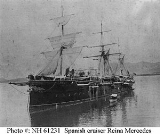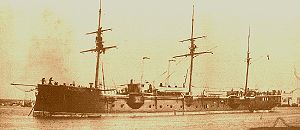
Spanish cruiser Reina Mercedes
Encyclopedia
Reina Mercedes, was an Alfonso XII-class
unprotected cruiser of the Spanish Navy
.
During the Spanish-American War
, Reina Mercedes was captured by the United States
and later salvaged and commissioned into the U.S. Navy. For information about her characteristics and operational history in U.S. Navy service, see USS Reina Mercedes (IX-25)
.
and launched on 9 September 1887. She had two funnels. Her main armament was built by Hontoria
and sponson-mounted. Her five torpedo tubes all were fixed; two were forward, one was on each beam, and one was aft. Although unprotected and therefore lacking armor, she had 12 watertight compartments built in a French-style cellular system to help her resist flooding. She was designed for colonial service, with high speed and moderate armament, but in practice chronic machinery problems made her a relatively slow steamer.
 Reina Mercedes spent her early years in Spanish waters as part of the Spanish Navy
Reina Mercedes spent her early years in Spanish waters as part of the Spanish Navy
's Instructional Squadron. In 1893 she was transferred to the Caribbean
, where she became flagship of Spanish naval forces operating in Cuban waters. When the Spanish-American War
broke out in April 1898, she was in the harbor at Santiago de Cuba
, on Cuba
's southeastern coast, awaiting repair, with seven of her ten boilers out of commission.
Little of military significance happened at Santiago de Cuba until Vice Admiral Pascual Cervera y Topete's squadron arrived there from Spain
to reinforce Spanish forces in the Caribbean on 19 May 1898. U.S. Navy forces hunting Cervera found him there on the evening of 27 May 1898, and a 37-day blockade of the harbor ensued.
During the blockade, Reina Mercedes traded blows with the American blockaders. On 3 June 1898, the U.S. Navy attempted to trap the Spanish ships in the harbor by sinking the collier USS Merrimac
in the entrance channel. Spanish shore batteries disabled Merrimac, and she drifted up the channel toward the anchored Spanish warships; Reina Mercedes, cruiser Vizcaya, and destroyer Pluton
opened fire on Merrimac as well, and the collier soon sank in a position which did not block the channel. Reina Mercedes took aboard as prisoners of war the eight Americans who had been aboard Merrimac.
On 6 June 1898, the blockading U.S. warships bombarded the harbor, hitting Reina Mercedes 35 times, starting two fires aboard her, and killing her second-in-command, Commander Emilio Acosta y Eyermann, the first Spanish naval officer to die in the war.
 By the beginning of July 1898, U.S. Army forces advancing overland seemed to be on the verge of capturing Santiago de Cuba, prompting Cervera to order his squadron to attempt an escape by running the blockade. Reina Mercedes could not follow because of her boiler problems. It was decided that most of her guns would be placed ashore to aid in the defense of Santiago de Cuba and that she would be sunk in the entrance channel to prevent her capture and to improve the harbor's defenses by preventing American ships from entering it.
By the beginning of July 1898, U.S. Army forces advancing overland seemed to be on the verge of capturing Santiago de Cuba, prompting Cervera to order his squadron to attempt an escape by running the blockade. Reina Mercedes could not follow because of her boiler problems. It was decided that most of her guns would be placed ashore to aid in the defense of Santiago de Cuba and that she would be sunk in the entrance channel to prevent her capture and to improve the harbor's defenses by preventing American ships from entering it.
On 3 July 1898, Cervera's squadron attempted its escape, and was completely destroyed in the Battle of Santiago de Cuba
. At about 2000 hours on 4 July 1898, Reina Mercedes, by now without most of her guns, slipped her moorings and proceeded into the channel. Just before midnight, battleship USS Massachusetts
spotted her and, together with battleship USS Texas
opened fire. Although Reina Mercedes took may hits, her scuttling crew stayed on course, dropped anchor, and detonated their scuttling charges, but Reina Mercedes drifted to the eastern edge of the channel before sinking, going down in a location that failed to block the channel.
Between 2 January 1899 and 1 March 1899, the U.S. Navy raised her and later put her into service as the disarmed receiving ship .
Alfonso XII class cruiser
The Alfonso XII class of unprotected cruisers was a series of three cruisers built during the 1880s for service with the Spanish Navy. They were named for a recent Spanish king and two recent Spanish queens.- Description :...
unprotected cruiser of the Spanish Navy
Spanish Navy
The Spanish Navy is the maritime branch of the Spanish Armed Forces, one of the oldest active naval forces in the world. The Armada is responsible for notable achievements in world history such as the discovery of Americas, the first world circumnavigation, and the discovery of a maritime path...
.
During the Spanish-American War
Spanish-American War
The Spanish–American War was a conflict in 1898 between Spain and the United States, effectively the result of American intervention in the ongoing Cuban War of Independence...
, Reina Mercedes was captured by the United States
United States
The United States of America is a federal constitutional republic comprising fifty states and a federal district...
and later salvaged and commissioned into the U.S. Navy. For information about her characteristics and operational history in U.S. Navy service, see USS Reina Mercedes (IX-25)
USS Reina Mercedes (IX-25)
USS Reina Mercedes was an unprotected cruiser of the Spanish Navy which was captured in Cuba in 1898 by the U.S. Navy during the Spanish-American War. She was refurbished and used by the U.S...
.
Technical Characteristics
Reina Mercedes was built by the naval shipyard at CartagenaCartagena, Spain
Cartagena is a Spanish city and a major naval station located in the Region of Murcia, by the Mediterranean coast, south-eastern Spain. As of January 2011, it has a population of 218,210 inhabitants being the Region’s second largest municipality and the country’s 6th non-Province capital...
and launched on 9 September 1887. She had two funnels. Her main armament was built by Hontoria
Hontoria
Hontoria is one of 28 parishes in Llanes, a municipality within the province and autonomous community of Asturias, in northern Spain.-Villages:* Cardoso * Hontoria* Villahormes...
and sponson-mounted. Her five torpedo tubes all were fixed; two were forward, one was on each beam, and one was aft. Although unprotected and therefore lacking armor, she had 12 watertight compartments built in a French-style cellular system to help her resist flooding. She was designed for colonial service, with high speed and moderate armament, but in practice chronic machinery problems made her a relatively slow steamer.
Operational history

Spanish Navy
The Spanish Navy is the maritime branch of the Spanish Armed Forces, one of the oldest active naval forces in the world. The Armada is responsible for notable achievements in world history such as the discovery of Americas, the first world circumnavigation, and the discovery of a maritime path...
's Instructional Squadron. In 1893 she was transferred to the Caribbean
Caribbean
The Caribbean is a crescent-shaped group of islands more than 2,000 miles long separating the Gulf of Mexico and the Caribbean Sea, to the west and south, from the Atlantic Ocean, to the east and north...
, where she became flagship of Spanish naval forces operating in Cuban waters. When the Spanish-American War
Spanish-American War
The Spanish–American War was a conflict in 1898 between Spain and the United States, effectively the result of American intervention in the ongoing Cuban War of Independence...
broke out in April 1898, she was in the harbor at Santiago de Cuba
Santiago de Cuba
Santiago de Cuba is the second largest city of Cuba and capital city of Santiago de Cuba Province in the south-eastern area of the island, some south-east of the Cuban capital of Havana....
, on Cuba
Cuba
The Republic of Cuba is an island nation in the Caribbean. The nation of Cuba consists of the main island of Cuba, the Isla de la Juventud, and several archipelagos. Havana is the largest city in Cuba and the country's capital. Santiago de Cuba is the second largest city...
's southeastern coast, awaiting repair, with seven of her ten boilers out of commission.
Little of military significance happened at Santiago de Cuba until Vice Admiral Pascual Cervera y Topete's squadron arrived there from Spain
Spain
Spain , officially the Kingdom of Spain languages]] under the European Charter for Regional or Minority Languages. In each of these, Spain's official name is as follows:;;;;;;), is a country and member state of the European Union located in southwestern Europe on the Iberian Peninsula...
to reinforce Spanish forces in the Caribbean on 19 May 1898. U.S. Navy forces hunting Cervera found him there on the evening of 27 May 1898, and a 37-day blockade of the harbor ensued.
During the blockade, Reina Mercedes traded blows with the American blockaders. On 3 June 1898, the U.S. Navy attempted to trap the Spanish ships in the harbor by sinking the collier USS Merrimac
USS Merrimac (1898)
USS Merrimac was a steamship in the United States Navy during the Spanish-American War.Merrimac was built by Swan & Hunter shipyard as SS Solveig in Wallsend, England, in November 1894. She was purchased by the US Navy in April 1898. Rear Admiral William T...
in the entrance channel. Spanish shore batteries disabled Merrimac, and she drifted up the channel toward the anchored Spanish warships; Reina Mercedes, cruiser Vizcaya, and destroyer Pluton
Spanish destroyer Pluton
Plutón, was an Audaz-class destroyer of the Spanish Navy that fought at the Battle of Santiago de Cuba during the Spanish-American War.-Technical characteristics:...
opened fire on Merrimac as well, and the collier soon sank in a position which did not block the channel. Reina Mercedes took aboard as prisoners of war the eight Americans who had been aboard Merrimac.
On 6 June 1898, the blockading U.S. warships bombarded the harbor, hitting Reina Mercedes 35 times, starting two fires aboard her, and killing her second-in-command, Commander Emilio Acosta y Eyermann, the first Spanish naval officer to die in the war.

On 3 July 1898, Cervera's squadron attempted its escape, and was completely destroyed in the Battle of Santiago de Cuba
Battle of Santiago de Cuba
The Battle of Santiago de Cuba, fought between Spain and the United States on 3 July 1898, was the largest naval engagement of the Spanish-American War and resulted in the destruction of the Spanish Navy's Caribbean Squadron.-Spanish Fleet:...
. At about 2000 hours on 4 July 1898, Reina Mercedes, by now without most of her guns, slipped her moorings and proceeded into the channel. Just before midnight, battleship USS Massachusetts
USS Massachusetts (BB-2)
USS Massachusetts was an and the second United States Navy ship comparable to foreign battleships of the time. Authorized in 1890 and commissioned six years later, she was a small battleship, though with heavy armor and ordnance. The ship class also pioneered the use of an intermediate battery...
spotted her and, together with battleship USS Texas
USS Texas (1892)
USS Texas was a second-class pre-dreadnought battleship built by the United States in the early 1890s. She was the first American battleship and the first ship named in honor of the state of Texas to be built by the United States...
opened fire. Although Reina Mercedes took may hits, her scuttling crew stayed on course, dropped anchor, and detonated their scuttling charges, but Reina Mercedes drifted to the eastern edge of the channel before sinking, going down in a location that failed to block the channel.
Between 2 January 1899 and 1 March 1899, the U.S. Navy raised her and later put her into service as the disarmed receiving ship .

